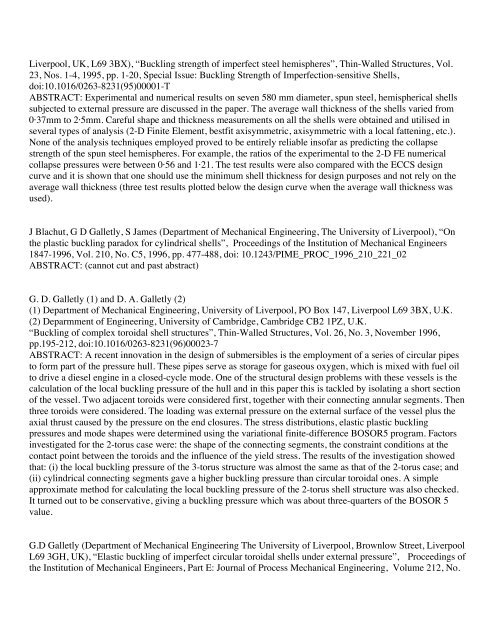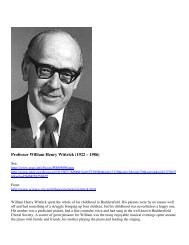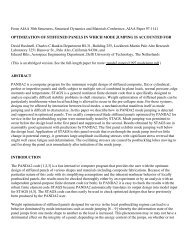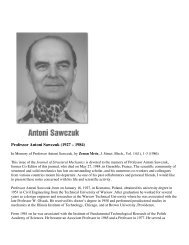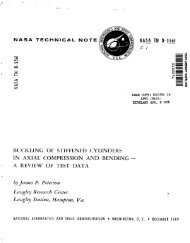Professor Gerard D. Galletly - Shellbuckling.com
Professor Gerard D. Galletly - Shellbuckling.com
Professor Gerard D. Galletly - Shellbuckling.com
You also want an ePaper? Increase the reach of your titles
YUMPU automatically turns print PDFs into web optimized ePapers that Google loves.
Liverpool, UK, L69 3BX), “Buckling strength of imperfect steel hemispheres”, Thin-Walled Structures, Vol.<br />
23, Nos. 1-4, 1995, pp. 1-20, Special Issue: Buckling Strength of Imperfection-sensitive Shells,<br />
doi:10.1016/0263-8231(95)00001-T<br />
ABSTRACT: Experimental and numerical results on seven 580 mm diameter, spun steel, hemispherical shells<br />
subjected to external pressure are discussed in the paper. The average wall thickness of the shells varied from<br />
0·37mm to 2·5mm. Careful shape and thickness measurements on all the shells were obtained and utilised in<br />
several types of analysis (2-D Finite Element, bestfit axisymmetric, axisymmetric with a local fattening, etc.).<br />
None of the analysis techniques employed proved to be entirely reliable insofar as predicting the collapse<br />
strength of the spun steel hemispheres. For example, the ratios of the experimental to the 2-D FE numerical<br />
collapse pressures were between 0·56 and 1·21. The test results were also <strong>com</strong>pared with the ECCS design<br />
curve and it is shown that one should use the minimum shell thickness for design purposes and not rely on the<br />
average wall thickness (three test results plotted below the design curve when the average wall thickness was<br />
used).<br />
J Blachut, G D <strong>Galletly</strong>, S James (Department of Mechanical Engineering, The University of Liverpool), “On<br />
the plastic buckling paradox for cylindrical shells”, Proceedings of the Institution of Mechanical Engineers<br />
1847-1996, Vol. 210, No. C5, 1996, pp. 477-488, doi: 10.1243/PIME_PROC_1996_210_221_02<br />
ABSTRACT: (cannot cut and past abstract)<br />
G. D. <strong>Galletly</strong> (1) and D. A. <strong>Galletly</strong> (2)<br />
(1) Department of Mechanical Engineering, University of Liverpool, PO Box 147, Liverpool L69 3BX, U.K.<br />
(2) Deparmment of Engineering, University of Cambridge, Cambridge CB2 1PZ, U.K.<br />
“Buckling of <strong>com</strong>plex toroidal shell structures”, Thin-Walled Structures, Vol. 26, No. 3, November 1996,<br />
pp.195-212, doi:10.1016/0263-8231(96)00023-7<br />
ABSTRACT: A recent innovation in the design of submersibles is the employment of a series of circular pipes<br />
to form part of the pressure hull. These pipes serve as storage for gaseous oxygen, which is mixed with fuel oil<br />
to drive a diesel engine in a closed-cycle mode. One of the structural design problems with these vessels is the<br />
calculation of the local buckling pressure of the hull and in this paper this is tackled by isolating a short section<br />
of the vessel. Two adjacent toroids were considered first, together with their connecting annular segments. Then<br />
three toroids were considered. The loading was external pressure on the external surface of the vessel plus the<br />
axial thrust caused by the pressure on the end closures. The stress distributions, elastic plastic buckling<br />
pressures and mode shapes were determined using the variational finite-difference BOSOR5 program. Factors<br />
investigated for the 2-torus case were: the shape of the connecting segments, the constraint conditions at the<br />
contact point between the toroids and the influence of the yield stress. The results of the investigation showed<br />
that: (i) the local buckling pressure of the 3-torus structure was almost the same as that of the 2-torus case; and<br />
(ii) cylindrical connecting segments gave a higher buckling pressure than circular toroidal ones. A simple<br />
approximate method for calculating the local buckling pressure of the 2-torus shell structure was also checked.<br />
It turned out to be conservative, giving a buckling pressure which was about three-quarters of the BOSOR 5<br />
value.<br />
G.D <strong>Galletly</strong> (Department of Mechanical Engineering The University of Liverpool, Brownlow Street, Liverpool<br />
L69 3GH, UK), “Elastic buckling of imperfect circular toroidal shells under external pressure”, Proceedings of<br />
the Institution of Mechanical Engineers, Part E: Journal of Process Mechanical Engineering, Volume 212, No.


